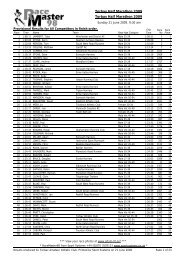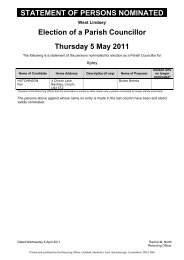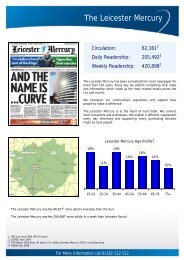A cArbon cApture And storAge network for yorkshire And humber
A cArbon cApture And storAge network for yorkshire And humber
A cArbon cApture And storAge network for yorkshire And humber
You also want an ePaper? Increase the reach of your titles
YUMPU automatically turns print PDFs into web optimized ePapers that Google loves.
9.4 DISCOUNT RATE<br />
The decision to use an appropriate discount<br />
rate to evaluate the cost of CCS is highly<br />
important. There are a variety of discount<br />
rates that could be used in this study.<br />
Choosing the correct rate <strong>for</strong> a cost analysis<br />
or CBA is important because society wishes,<br />
in principle, to undertake a mix of public and<br />
private investments that can maximize social<br />
well-being. To undertake an investment, the<br />
expected return on that investment must<br />
cover all costs (investment, operation and<br />
maintenance costs), including the rate of<br />
interest. Under fairly restrictive assumptions,<br />
one can argue that the investment will<br />
continue until returns across alternatives<br />
are the same and just balance the returns<br />
required by savers. Under these conditions,<br />
one can argue that a single interest rate and<br />
a single rate of return on capital will prevail<br />
throughout the economy. In reality, however,<br />
there are a number of reasons that multiple<br />
rates prevail. The choice facing the decision<br />
maker is which of these many rates may<br />
apply in a CBA.<br />
There are several important points that need<br />
to be considered when we make a decision<br />
on the discount rate:<br />
Higher interest rate verses lower<br />
interest rates – although it is possible to<br />
define the reasons that differentiate interest<br />
rates, it does not mean that choosing a<br />
rate <strong>for</strong> analysis is a simple task. On the<br />
contrary, in the final analysis the choice of<br />
a rate is fairly arbitrary. For this reason, it is<br />
typically the case that individuals who are<br />
in favour of larger government investments<br />
to protect the environment can make<br />
arguments <strong>for</strong> low rates, whereas those who<br />
would prefer less government involvement<br />
in the economy can make equally plausible<br />
arguments <strong>for</strong> higher rates. It is clearly the<br />
case that higher interest rates will lead<br />
to fewer projects presenting positive net<br />
present values than lower ones.<br />
Carbon Capture and Storage Network 35<br />
Un<strong>for</strong>tunately, the arguments used<br />
to support both these positions are<br />
complicated and fail to lead to a definitive<br />
solution. Undertaking an additional public<br />
project will be possible through displacing<br />
private consumption, private investment<br />
or some fraction of both. If one displaces<br />
consumption by undertaking the public<br />
investment, then the appropriate discount<br />
rate is the consumer’s after tax time<br />
preference, a relatively low rate of return.<br />
If one displaces private investment the<br />
investment displaced is at a higher, be<strong>for</strong>e<br />
tax rate of return. Because the purpose of<br />
CBA is to increase public well-being, it does<br />
not want to use parameter variables that<br />
lower the effective national rate of return<br />
on investment or variables that displace<br />
consumption by consumers inappropriately.<br />
There are several approaches that have<br />
been suggested to cope with this problem.<br />
If one knew the proportion at which<br />
the public investment displaced private<br />
investment and private consumption<br />
he/she could weigh the two and <strong>for</strong>m an<br />
average discount rate accordingly. Taking<br />
the above into consideration, perhaps,<br />
more appropriately one could apply a more<br />
complicated model to take into account the<br />
fact that the costs and benefits specifically<br />
related to the displaced private consumption<br />
and displaced private investment occur<br />
at different points in time. In practice,<br />
in<strong>for</strong>mation needed <strong>for</strong> either approach<br />
is generally unavailable. Thus, the debate<br />
appears to return to personal preference <strong>for</strong><br />
public investment.<br />
Inflation – It is difficult to model the range<br />
of expectations, but, unless specifically<br />
defined and modelled, there is implicit rate<br />
within a total discount rate that reduces a<br />
series of numbers over time to a present<br />
value. We currently have a period of low<br />
inflation that sees 1.5 to 3% inflation as<br />
normal. For the purposes of time adjustment<br />
to input costs, and including implicitly within<br />
discount rates a single figure has been used<br />
<strong>for</strong> this study.<br />
Impact of taxes – Conflict in choosing a<br />
rate generally arises over the role that taxes<br />
play in determining interest rates. Because<br />
of corporate income taxes and personal<br />
income taxes, the rate of return on a private<br />
investment is greater than the after tax<br />
return. It is also true that the consumer<br />
after tax rate of return time preference is<br />
lower than the be<strong>for</strong>e tax rate of return. This<br />
means that consumers make the decision<br />
of how much to save based on the after tax<br />
rate of return, while business investors make<br />
the decision of how much to invest based<br />
on be<strong>for</strong>e tax rates of return.<br />
Climate change issues – Debates over<br />
long-term environmental issues such as<br />
global climate change (control of CO2<br />
release) tend to focus on inter-generational<br />
equity, rather than intra-generational<br />
efficiency. The choice of an interest rate is<br />
largely a pursuit to help the public sector<br />
choose investments that will improve the<br />
over-all level of national economic well-being<br />
<strong>for</strong> a given set of consumers and investors.<br />
Many investments take place over long timespans,<br />
some of which are long enough to be<br />
inter-generational. A decision to undertake<br />
CO2 abatement to reduce the probability of<br />
global warming is a decision to <strong>for</strong>go the<br />
increment of consumption or retirement<br />
<strong>for</strong>ever. Moreover, because most benefits<br />
will occur long into the future, almost any<br />
reasonable discount rate, even one reflecting<br />
consumption time preference, rather than<br />
private rate of return, will suggest that the<br />
project is inefficient. For these reasons,<br />
attention turns from efficiency concerns,<br />
getting the right rate of private and public<br />
rates of return, to equity concerns, taking<br />
into account the rights of future generations.<br />
Economists argue generally a social rate<br />
of time preference is appropriate <strong>for</strong> intergenerational<br />
discounting, which would be<br />
composed of two components.

















